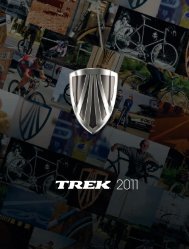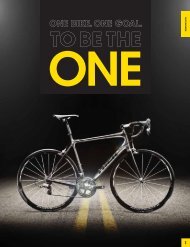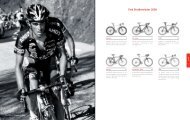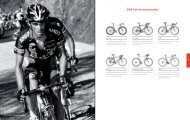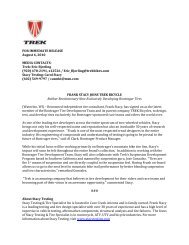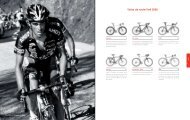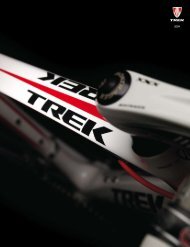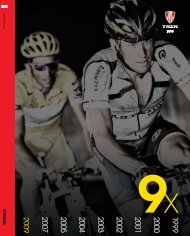Airfoil Development for the Trek Speed Concept ... - Slowtwitch.com
Airfoil Development for the Trek Speed Concept ... - Slowtwitch.com
Airfoil Development for the Trek Speed Concept ... - Slowtwitch.com
You also want an ePaper? Increase the reach of your titles
YUMPU automatically turns print PDFs into web optimized ePapers that Google loves.
2.3 Production Bike: July 2009 – March 2010<br />
<strong>Trek</strong> engineers would spend <strong>the</strong> next year refining <strong>the</strong> team <strong>Speed</strong> <strong>Concept</strong> design into <strong>the</strong> production <strong>Speed</strong> <strong>Concept</strong> found at<br />
<strong>Trek</strong> Dealers today. In fact, since <strong>the</strong> June 2009 wind tunnel tests, <strong>Trek</strong> has dedicated an additional 1,200 wind tunnel runs directly<br />
towards <strong>Speed</strong> <strong>Concept</strong> development and testing, bringing <strong>the</strong> total up to 2,100 runs. This ongoing development culminated in a<br />
final head-to-head showdown at <strong>the</strong> San Diego Low <strong>Speed</strong> Wind Tunnel in March 2010. This final data is shown in <strong>the</strong> figure below.<br />
Figure 11: Drag of several popular triathlon bikes.<br />
Notes: <strong>Trek</strong>’s wind tunnel test standards are described in Appendix 4. The P4 was tested with its integrated aero<br />
bottle because this is its most aero configuration [21]. The 2010 Felt B2 has <strong>the</strong> same frame and <strong>for</strong>k shape as <strong>the</strong><br />
Felt DA, so <strong>the</strong> drag is almost certainly <strong>the</strong> same [7]. The <strong>Speed</strong> <strong>Concept</strong> has replaced <strong>the</strong> TTX as <strong>Trek</strong>’s baseline<br />
test bike. San Diego Low <strong>Speed</strong> Wind tunnel. Without rider. Disc rear wheel and Bontrager Aeolus 9.0 front wheel.<br />
Tares removed.<br />
As can be seen, <strong>the</strong> <strong>Speed</strong> <strong>Concept</strong> OCLV had <strong>the</strong> least drag by a huge margin, with <strong>the</strong> <strong>Speed</strong> <strong>Concept</strong> TCT <strong>com</strong>ing in second<br />
overall. Over <strong>the</strong> entire yaw range, <strong>Speed</strong> <strong>Concept</strong> OCLV has an average of 91 grams less drag than <strong>the</strong> Cervélo P4, <strong>the</strong> closest<br />
overall <strong>com</strong>petitor. With an average of 22 grams less drag than <strong>the</strong> closest overall <strong>com</strong>petitor, <strong>the</strong> <strong>Speed</strong> <strong>Concept</strong> TCT was <strong>the</strong><br />
second fastest bike tested. At 15˚ of yaw (a fairly <strong>com</strong>mon condition – see Section 4), <strong>the</strong> <strong>Speed</strong> <strong>Concept</strong> OCLV and <strong>Speed</strong><br />
<strong>Concept</strong> TCT have 169 and 83 grams less drag than any o<strong>the</strong>r bike tested. Considering that in this configuration <strong>the</strong> <strong>Speed</strong><br />
<strong>Concept</strong>’s drag at 15˚ yaw is only 405 grams total, <strong>the</strong>se drag savings are immense.<br />
12




